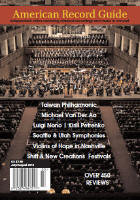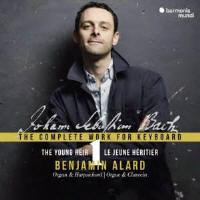Texte paru dans: / Appeared in: |
|
|
Outil de traduction ~ (Très approximatif) |
|
|
Reviewer: Bradley
Lehman The subtitle is “The Young Heir”. This slim boxed set gives us pieces that Bach knew or composed before he turned 20 in 1705. It is the first volume in a series to record all of Bach’s harpsichord and organ music played by one musician. Rhat’s a big enterprise. Collectors will already have their own favorite recordings by hundreds of other organists and harpsichordists. Convenient composite sets are readily available, and so are countless shorter programs. So, why do this?
Alard is in his early 30s. He
switches adeptly between organ and harpsichord. The biographical notes tell
us he practices also on clavichord, which is excellent background for
knowing the music, but it’s not clear if he will perform any pieces on
clavichord in the series.His choice of instrument sometimes seems haphazard
(so far), perhaps to shake us up or simply to offer variety. It’s refreshing
to hear he doesn’t merely continue the 19th Century prejudice in the
numerical cataloguing of Bach’s music, demarcating “organ” vs “keyboard”
works. That prejudice generally had the following criteria: if there’s a
pedal part or a chorale tune, it’s for organ; otherwise it’s not. I hope
Alard will use some pedal harpsichord and pedal clavichord when he gets to
Bach’s later music.
Alard’s harpsichord is a modern one based on some Flemish models. He tunes it in a crudely circulating system—again, no information supplied. We encounter distractingly spicy spots in it whenever Bach’s music calls for sharps beyond G-sharp or flats beyond Eflat. Alard transposes the big capriccio in E (S993) to C without comment, making it sound wrong in character. Presumably, that change was made to dodge the severe enharmonic limitations of the organ in 1/6-comma meantone temperament, but it doesn’t work all the way through the piece. The transposition merely delays the wrecks until other sections. (No other transposition would have worked completely, either, so why not just play the piece on a more moderately-tuned instrument?)
He plays the other pieces in the keys Bach wrote them, letting the tuning mishaps occur where they are. The last page of Ach Gott, vom Himmel sieh Darein (S 741) is painful every time an A-flat occurs, because the organ is tuned with G-sharp (also needed in this piece). If Alard stays at this limited organ for the rest of his series, the result will be a cacophonous mess. Again, the pseudo-historicity is unconvincing. All of this sour out-of-tuneness seems to imply that young Bach perhaps didn’t care or didn’t know any better—or was at the mercy of other people tuning badly for his music. Why, then, did he write his earliest music with such exotic notes that don’t exist in restrictive meantone-based schemes? His music is evidence that he didn’t confine himself to primitive tuning systems. The strongest draw is disc 1, where Alard plays representative music Bach learned or created as a student in Ohrdruf. He has compositions by nine other composers interspersed with Bach’s earliest pieces. The other two discs give us Bach in Luneburg and Arnstadt, but no guest composers.
For some of the chorale-based pieces Alard brings in soprano Gerlinde Samann to sing the melody. The booklet says nothing about her, but her biography (elsewhere) reveals she is about 15 years older than Alard. She has a clear voice and sings well in a simple manner, often sounding almost like a young choirboy. Alard accompanies these Lutheran chorales from straightforward settings in the same keys as the chorale preludes he has just played. It’s a nice way to give variety to the program. It alleviates the tedium of hearing long sets of organ preludes in succession. I heard some editing errors. One is at the end of the other capriccio (in B-flat, S 992), also played on organ. Another error is at the beginning of a chorale sung by Samann. She gets her starting pitch from the resounding tone of a bell, but we don’t get to hear the begin-ning of that bell stroke.
It is not clear whether Alard will remake the pieces he has already recorded for the Alpha and Hortus labels years ago or include them in Harmonia Mundi’s ambitious series. I liked the Alpha set of Partitas. Readers seeking this music from Bach’s youngest years can do better by acquiring the two Hanssler programs played by Robert Hill on harpsichord (1999, not reviewed). Hill plays with more effusive ornamentation. His intonation is more appropriate to the notes required in these scores. His imaginative performances make the music sound more mature and entertaining than Alard’s simpler approach does.
| |
|
|
|
|
Cliquez l'un ou l'autre
bouton pour découvrir bien d'autres critiques de CD |
|




